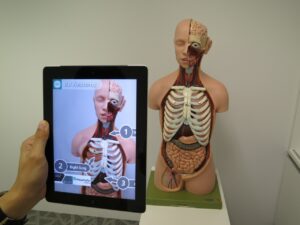Introduction to Augmented Reality
Augmented reality (AR) has been around since the early 1980s, but it’s only recently become more mainstream. This technology allows users to visualize and interact with the real world by overlaying virtual objects onto their physical surroundings. This technology has been used in various industries, from education and healthcare to architecture and retail. We spoke to a couple of experts about how AR is changing the way we interact with the physical world. AR is transforming the way we interact with the physical world Augmented Reality: The technology behind it Augmented reality is not a new concept. It’s been around since the early 1980s and it’s been used in the field of healthcare. At the time, doctors would use an AR headset and then place an image on a screen which would then be reflected into the real world in front of them.
History of Augmented Reality
Augmented reality (AR) is a technology that overlays digital information or graphics over the real world. It can be used to visualize and interact with digital content, such as maps, directions, and other images, through the use of smartphones and wearable devices. It can be applied to a variety of scenarios, including educational tools, training, and even in-store marketing. The first step of an AR application is to capture the environment using a sensor, such as a camera. The sensor then converts the image into a digital format and sends it to a smartphone or other device. The smartphone or device then displays the image and digital information (such as graphics) over the captured environment.
Benefits of Augmented Reality
Augmented reality is a technology that uses computer-generated graphics and images to augment a person’s perception of reality. By overlaying real-world objects onto the user’s view of the environment, augmented reality can enhance the user’s interaction with the world around him or her, providing a new way of perceiving information. The most widely used example of augmented reality is Google Glass, which Google released in 2013. The device was a pair of glasses that allowed the user to view their smartphone’s display.
Types of Augmented Reality
AR (augmented reality) is a technology that overlays virtual objects on the real world. It is also referred to as MR, for mixed reality. AR is becoming increasingly popular with gaming, training, education, advertising, architecture, retail, engineering, and productivity industries. AR can be used to augment reality by adding virtual objects, maps, and graphics to the real world.
Advantages of Augmented Reality
Augmented reality (AR) is an advanced form of technology that overlays digital content onto the real world. With the help of mobile devices, AR allows users to interact with the real world in a new way, turning everyday objects into virtual reality. By creating digital environments that merge with the physical world, AR has the potential to help people with various disabilities, from the blind to the deaf. AR is being used in a wide variety of applications, from education and training to gaming and medicine. For example, AR-enabled devices allow for real-time translations and provide information that cannot be found in books or other printed materials. In addition, AR can be used to augment reality in the classroom to provide students with access to information not available in the physical world. AR technology can also be used in the healthcare industry to make diagnoses and treatments more efficient and accurate.
Disadvantages of Augmented Reality
Although augmented reality technology has the potential to be beneficial in a variety of settings, it can also pose a number of challenges. By understanding these disadvantages, we can better utilize the technology to benefit our lives. While Augmented Reality in Healthcare may be beneficial, it also has the potential to pose a number of challenges. By understanding these disadvantages, we can better utilize the technology to benefit our lives. By understanding the advantages and disadvantages, the technology can be used to improve the quality of our lives. Disadvantages of Augmented Reality in Healthcare There are many disadvantages of augmented reality in healthcare. The technology has a number of disadvantages, including but not limited to the following: Privacy Concerns One of the main concerns with augmented reality technology is that the technology will become more invasive and intrusive to the user.
Real-Life Examples of Augmented Reality

Augmented reality (AR) refers to the integration of real-world imagery with virtual objects and environments. It is used to enhance reality in order to provide users with new and more informative ways to view the world around them. While it can be used to help people navigate the physical world, AR can also be utilized to communicate important information to them and to interact with them in new and exciting ways. In the healthcare field, the use of AR for patient care has been gaining interest as well. One of the first AR applications for healthcare was developed by Qualcomm in 2011 for use with hearing aids. While hearing aids can provide basic information to a person in need, it was not always the most convenient or effective method. AR hearing aids are capable of projecting and capturing sound, while at the same time enhancing the listening experience by presenting information on top of the sound.
Conclusion: Where Do We Go From Here?
As we continue to grow and adapt to technological advances, it is important to consider the impact of technology on our lives. By utilizing digital technology to augment our real world experiences, we can learn to navigate our environment with greater ease and improve the overall quality of our lives. For example, the advent of technology has allowed us to use our phones to take and send pictures with little effort, allowing us to easily capture and share moments with friends, family and acquaintances. Similarly, we can now use technology to assist us with physical challenges that might not be possible in our everyday lives. A recent study from the National Center for Biotechnology Information (NCBI) and the National Institute of Neurological Disorders and Stroke (NINDS) found that a new class of medications, known as “neurostimulators,” has shown significant promise in treating movement disorders.








No Comment! Be the first one.